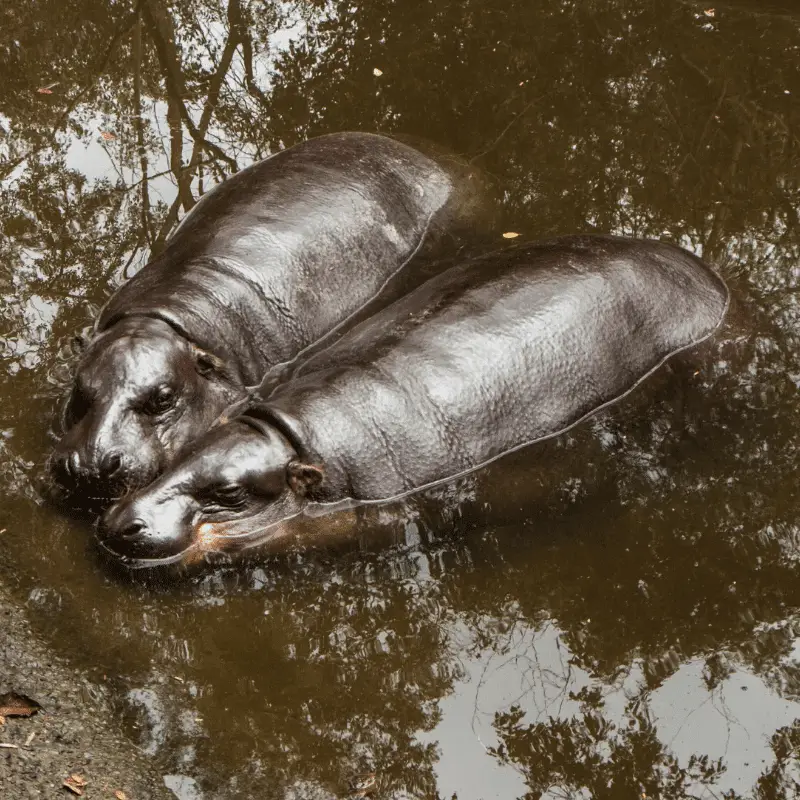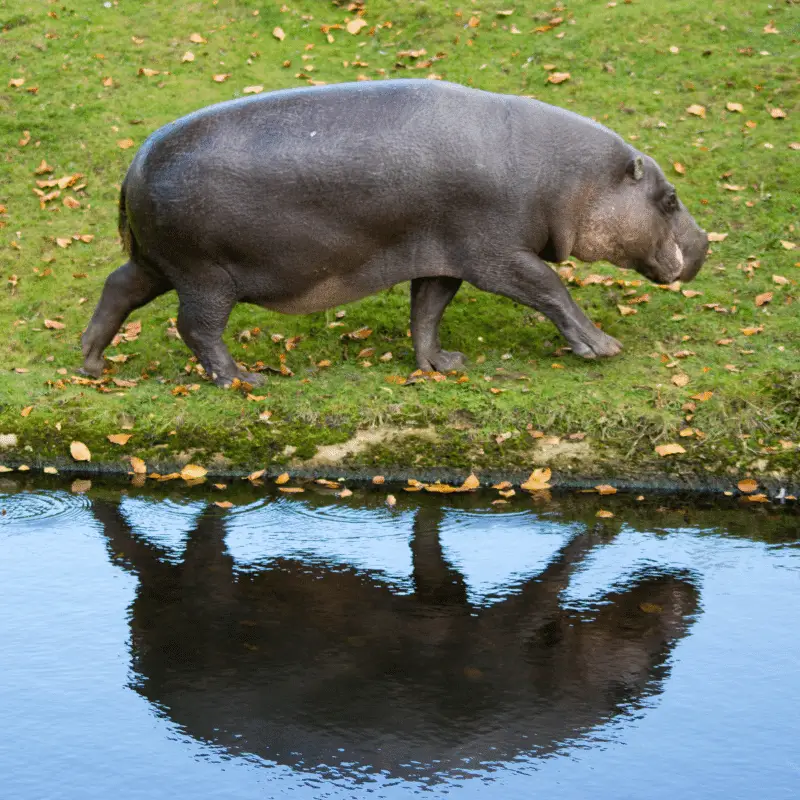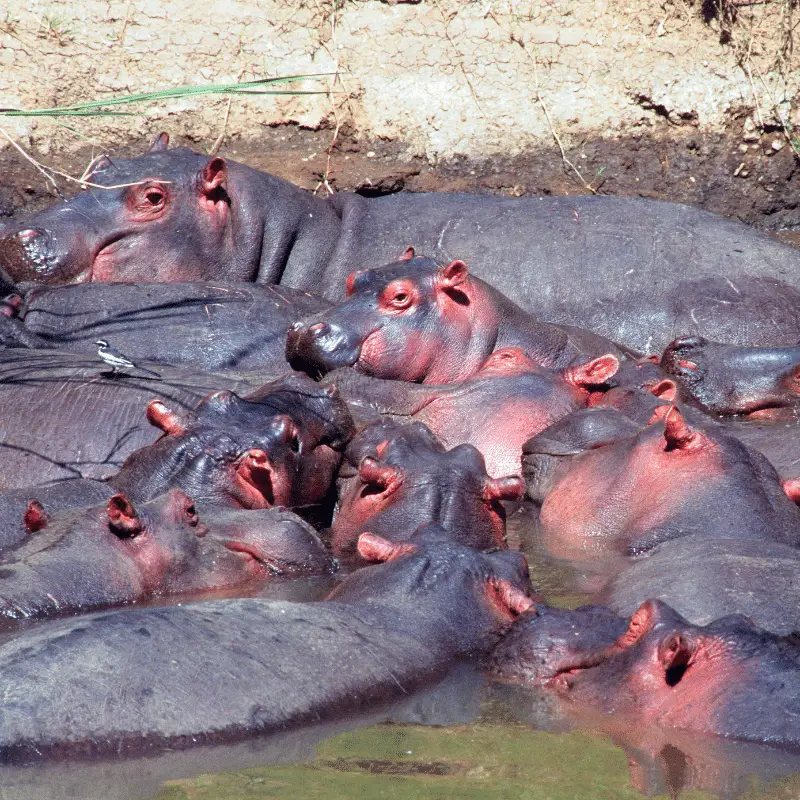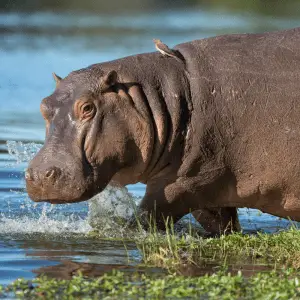Hippos live in groups to protect each other and their babies from being attacked by predators like lions, crocodiles, and hyenas. Because these animals can’t take down these strong animals on their own, however, when together in a group, they will work as a team, and they can easily win against a single hippo.
Recommended Read: Why dont crocodiles attack hippos?
The most dominant and mighty male hippopotamus often guides the group and defends his position by leading any attacks.
Hippos generally tolerate submissive male hippos in their territory as long as they do not try to mate with any of the females in the same group. In most cases, adult male hippopotamuses mark their territory in water and inland by spraying their faeces and urine in every direction. Brutal hippo fighting will commence if another dominant male hippopotamus has stepped into another male’s domain.
Do all types of hippos live in groups?
You can see the common hippopotamuses living in a group. Even though these animals are ill-tempered and ferocious, they are also very social and companionable to each other. That is why these animals can live together. However, the pygmy hippopotamus is not a social animal. Generally, you will find these pygmy hippos wandering alone in the African windedness and occasionally with another, usually a sibling or a mother and child.
Living Arrangements of The Common Hippopotamuses
The common hippopotamus, indeed, prefers to live in groups. On average, hippos can form groups of up to 30 hippopotamuses. Although some single groups, if they all get along, may contain more than a hundred hippopotamuses.
The groups generally consist of both the mother hippos and their youngsters. Most of the time, a single full-grown dominant adult male hippopotamus keeps a close watch on the group members and keeps them safe.
What is a group of hippos called?
A group of hippos are called a “bloat.” There might be 10-20 male and female hippos in one bloat. Sometimes there could be more than 100. A dominant male leads the group. Other names for groups of hippos are “schools,” “crash”, or “pod.”
The Relationship Dynamics Between the Common Hippopotamuses
Even though the common hippopotamuses are sociable animals, they do not form lifelong relationships with each other. The group members often showcase detached and solitary behaviour with each other.
Regarding the relationships between the hippopotamuses, you need to understand that nothing is set in stone. The groups that the dominant hippopotamus creates are in no way a permanent solution. They mainly communicate with each other when there is a threat.
Living Arrangements of Pygmy Hippos


Even though aesthetically, the common hippopotamuses and the pygmy hippos look pretty similar, their lifestyle varies significantly. The nocturnal small-sized reclusive hippopotamuses live their life independently. You can often find a pygmy hippopotamus roaming in the wild on their own.
Exceptions, in some cases, do exist. Occasionally, you can find a couple of pygmy hippopotami living together in a group. However, compared to the groups formed by the common hippopotamus, the group of the pygmy hippopotamus is tiny. These small-sized hippos form a primary family group that consists of only the parents and their babies or siblings most of the time.
The main pygmy hippopotamuses are much more even-tempered compared to the common hippos. In most cases, pygmy hippos only interact with each other to fulfil their mating needs. Living alone in the wild goes exceptionally well for these hippopotamuses, who thrive in this lifestyle.
The Relationship Between Pygmy hippos
Even though you will not find pygmy hippos staying close to each other very often, they are also not hostile towards each other.
Most of the time, the pygmy hippos do not attack an unfamiliar member of their species without provocation. These solitary animals mostly choose to ignore other hippos present in their vicinity.
The fundamental territorial nature of the common hippos is quite the same among the pygmy hippos. Despite their small size, they can show significant aggression when defending their territory. If a male hippopotamus tries to bridge the part of another male, there will be a head-on confrontation.
The Mating Habit Of The Hippos
Hippopotamuses are the only land animals that mate underwater. When the female hippopotamus is ready for mating, she enters a dominant male’s territory.
During this time, the female hippos must maintain a respectful attitude towards the dominant male as she enters his territory volunteering. The mating process is entirely underwater.
During the mating process, the male hippopotamus forcibly submerges the female one to complete it. Mating underwater is surprising as the hippopotamus does not know how to swim. The head of the female hippo comes up to the water’s surface during intervals so that she can breathe.
The male hippopotamuses know that it is the right time to mate with the female by sniffing the urine of the female hippo to find out whether she is ready for mating. During mating time, the male hippo will always be around the females. You will always find the males following the females around everywhere.
The male hippopotamuses will fling their urine and faeces to the female hippos to express their interest. This process lasts for about three days. Once this phase is over, the mating process begins.
Even though hippos are social animals, they do not meet for life. Hippos are polyamorous by nature. That means, during the mating season, a single male hippo can mate with several female hippos living within its social group.
The mating process of the hippos is not simple as one thinks. Female hippos generally mate every two years. There is no specific season time for the mating process as, well. However, hippopotamuses usually mate at the end of the dry season or at the beginning of the rainy season. This mating behaviour is the same for the pygmy hippos and common hippos living in the African wild.
Recommended read







